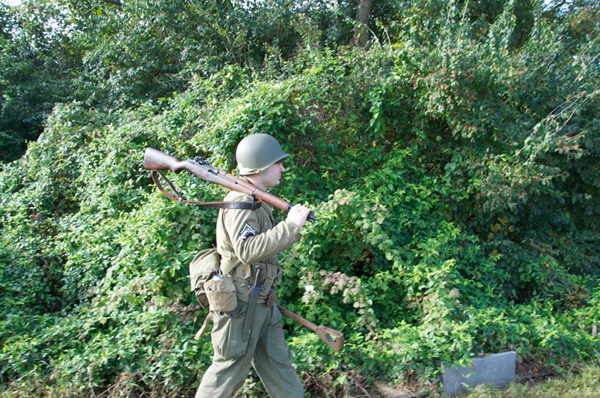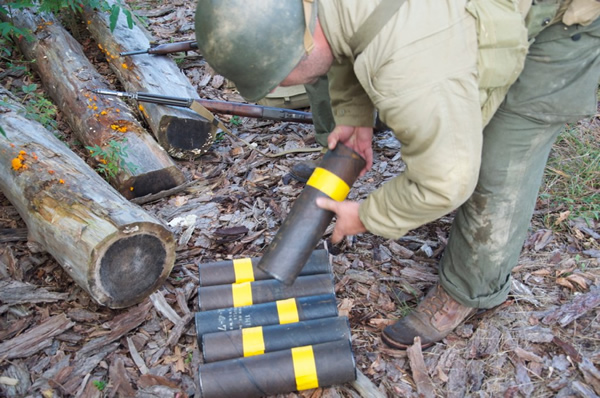Tableau Number 1
The 81mm Mortar Squad
Date: January 2013
Author: Chris Guska - 90th IDPG
On the Move
The mortar platoons are disposed so as best to facilitate movement and reduce exposure to hostile observation and fire. In accordance with the situation and terrain, they move by covered routes to the objective designated by the company commander or advance abreast of or following the machine gun platoons.
The squad leaders make the detailed reconnaissance for the exact location of the mortar emplacements
On completion of the reconnaissance, the squad is briefed and brought forward.
Emplacing
Firing Positions - The factors exercising most influence on the location of firing positions include: the location of targets and friendly front-line troops; requirements of cover and observation; fire direction by the company commander and the platoon leader; facility of ammunition supply
When assigned an appropriate position by the section leader, he fixes the exact location and directs the preparation of the emplacement (camouflage and entrenchment where required) and the movement of the mortar into position.
Mortar is laid on direction of fire - baseplate / aiming stake
Mortar is locked to the base plate
Mortar is properly mounted.
Clamp bolt is secure
Mortar is cross leveled and locking nut is secure
Chain is adjusted to limit the spread of the bipod legs
Bore is clean
Ammunition is prepared
Orders
The mortar squad is the basic fire unit...
Whenever practicable, the company commander designates the target areas and fixes conditions for opening fire. When as the result of restricted visibility or unusual extension of the battalion front, the fire of mortars cannot be directed by the company commander, the battalion commander attaches mortars by squad or section to one or more rifle companies of the leading echelon. In such case, the rifle company commander directs the fire of the 81mm as prescribed for the 60mm mortar.
...The section leader, or occasionally the platoon leader, may control the fire of either a section or the platoon by the liaison method, using a forward observer... The section leader directs the fire of squads by assignment of fire sectors or target areas and indication of the order of priority of fires. His instructions should be given while the section is still assembled.
During periods when the squads are separated by displacement, both squads may be assigned identical fire missions. Squad leaders regulate their fire action so as to support the general plan of attack of the battalion.
The squad leader exercises the functions of fire control and establishes an observation post that will permit him to observe fire on the target and to transmit commands to the crew by voice or arm and hand signals. He instructs the members of his squad in their duties as prescribed... and maintains fire discipline during action.
Initial Fire order Squad Leader Announces shell to be fired HIGH EXPLOSIVE, LIGHT Announces deflection LEFT 40, STAKE
Announces range 800 Announces quantity to be fired ONE ROUND Ammo Handlers Unpack Ammunition Gunner A-Gunners Consults the firing table A-Gunner 2 Announces the charge to be used Charge 1 Removes Increments to match charge Sets the sight in the dovetail A-Gunner 2 hands shell to A-Gunner 1 Lays for elevation 64 1/4 degrees Removes Safety wire Lays for deflection and cross levels simultaneously Left, 40 Starts shell into muzzle Orders FIRE Releases shell, withdraws hands, head and upper portion of body from muzzle. After the initial fire has been completed, the forward observer relays back corrections to the Squad Leader to fire for effect.
At this time, the Squad Leader either calls for adjusting fire for the target, or traversing and searching fire.
Adjusting Fire Squad Leader Announces shell to be fired HIGH EXPLOSIVE, HEAVY Announces deflection RIGHT 10, STAKE
Announces range 850 Announces quantity to be fired SIX ROUNDS Ammo Handlers Unpack Ammunition Gunner A-Gunners Consults the firing table A-Gunner 2 Announces the charge to be used CHARGE 2 Removes Increments to match charge Sets the sight in the dovetail A-Gunner 2 hands shell to A-Gunner 1 Lays for elevation 74 1/4 degrees Removes Safety wire Lays for deflection and cross levels simultaneously Right, 10 Starts shell into muzzle Orders FIRE Releases shell, withdraws hands, head and upper portion of body from muzzle. Upon completion of fire and when ready to displace, the Squad Leader calls Out of Action at which time the squad dismounts the mortar and prepares for movement.
Wrap Up:
We've presented what we feel are the core essential concepts and equipment for the US Army 81mm Mortar Squad in the ETO. From here, you should consider the following when you tailor your unit specific impression:
- Uniforms
- Field Gear
- Individual Weapons
- Mortar specific equipment
- Allocation of equipment
- Use of aiming stakes
- Ammunition vests
- Baseplate backpacks
- Shoulder pads
- Cleaning rods
- Communications equipment
- Muzzle covers
- Asbestos mittens
- Mortar Ammunition
- Quantity
- Types
- Packaging
The unit you portray and the action or campaign you are presenting makes a tremendous impact on each of the above points. Considerations for specific equipment items and ammunition packaging may impose date constraints and otherwise spoil an excellent presentation.
Be selective in constructing your impression and display as a group. While it may be tempting to bring out the full depth of the collection, it is far better to focus on the specific impression at hand to present the historically cleanest, accurate impression.
Clearly, the accessories and people make the impression come together as it should. We've found the process of putting the impression together as a unit to be highly gratifying, challenging and stimulating as reenactors. The 81mm Mortar Squad, when presented as a unit impression is highly engaging and educational for both reenactor and public alike.
Introduction
Section 1: By the book - TO&E
Section 2: Notes from the manuals on equipment
Section 3: Original Photographs - Key Observations
Section 4: Preparing for Fire - Operational Concepts
Section 5: Conducting Fire - Modern Interpretation (you are here)
Special Thanks
- 100th Infantry Division Preservation Group for their gracious invitation and sponsorship to USAHEC / Carlisle Barracks event. Without their invitation, progressive drive and members, this tableau would not have happened.
- Tom Kelly of the 100th Infantry Division Preservation Group for his conceptual and advisory role on this tableau.
- Mike Ellis of the 90th Infantry Division Preservation Group for the TO&E diagrams, document cleanup and editorial support.
- Lee Mudd of the 90th Infantry Division Preservation Group for research and editorial support.
90th IDPG Original Research















